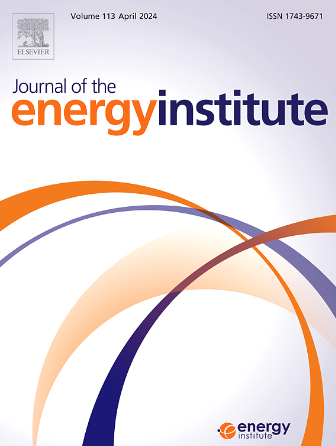灰熔化对玉米秸秆颗粒气化过程中的热量、质量特性和反应速率的影响
IF 5.6
2区 工程技术
Q2 ENERGY & FUELS
引用次数: 0
摘要
为了研究灰熔化对生物质颗粒气化过程的影响,建立了高温可视气化系统,同时建立了单一颗粒的生物质熔化气化模型。考虑到灰熔化温度范围为 1418 K 至 1558 K,实验温度分别选为 1396 K(1418 K 以下)、1491 K(1418 K 至 1558 K 之间)、1591 K 和 1677 K(1558 K 以上)。结果表明,灰熔化会吸收热量,从而阻碍颗粒内部的热量传递。当气化温度高于 1558 K 时,由于灰熔化和凝聚产生的较大球形颗粒从球团表面脱落,被熔化灰覆盖的球团可直接暴露在环境中,有利于传热和传质。本文章由计算机程序翻译,如有差异,请以英文原文为准。
Effect of the ash melting on heat and mass characteristics and reaction rate during corn stalk pellet gasification
In order to investigate the effect of ash melting on the gasification process of biomass pellet, a high-temperature visual gasification system was set up, meanwhile, a biomass melting gasification model for a single pellet was built. Considering that the fusion temperature range of ash is from 1418 K to 1558 K, 1396 K (below 1418 K), 1491 K (between 1418 K and 1558 K), 1591 K and 1677 K (above 1558 K) were chosen as the experimental temperatures. Results show that ash melting could absorb heat, thereby resisting the heat transfer inside pellet. When the gasification temperature is higher than 1558 K, as the larger spherical particles caused by ash melting and coalescing peels off from the pellet surface, the pellet covered by melting ash could be directly exposed to the environment, which is conducive to the heat and mass transfer.
求助全文
通过发布文献求助,成功后即可免费获取论文全文。
去求助
来源期刊

Journal of The Energy Institute
工程技术-能源与燃料
CiteScore
10.60
自引率
5.30%
发文量
166
审稿时长
16 days
期刊介绍:
The Journal of the Energy Institute provides peer reviewed coverage of original high quality research on energy, engineering and technology.The coverage is broad and the main areas of interest include:
Combustion engineering and associated technologies; process heating; power generation; engines and propulsion; emissions and environmental pollution control; clean coal technologies; carbon abatement technologies
Emissions and environmental pollution control; safety and hazards;
Clean coal technologies; carbon abatement technologies, including carbon capture and storage, CCS;
Petroleum engineering and fuel quality, including storage and transport
Alternative energy sources; biomass utilisation and biomass conversion technologies; energy from waste, incineration and recycling
Energy conversion, energy recovery and energy efficiency; space heating, fuel cells, heat pumps and cooling systems
Energy storage
The journal''s coverage reflects changes in energy technology that result from the transition to more efficient energy production and end use together with reduced carbon emission.
 求助内容:
求助内容: 应助结果提醒方式:
应助结果提醒方式:


